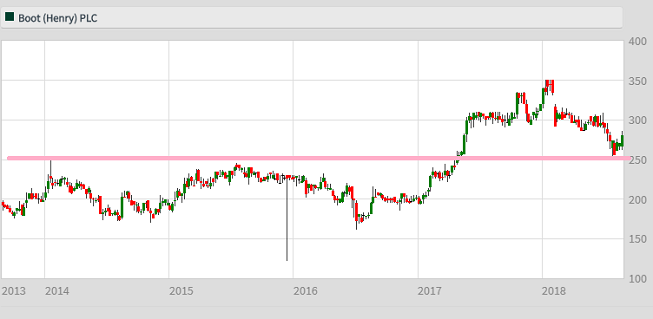Stockwatch: Investment value or fool's gold?
29th August 2018 09:54
by Edmond Jackson from interactive investor
Share on
After a long bull run since the financial crisis, companies analyst Edmond Jackson looks at where this cyclical company could be heading next.

It's a current dilemma that shares in perceived cyclical firms are weakening amid doubts over longevity of the economic cycle, and with Brexit looming. Price/earnings (PE) ratios drop and dividend yields rise, meanwhile trading updates affirm 2018 forecasts and managers broadly see nothing untoward.
Yet experienced investors know the market tends to pre-empt a slowdown, and that some of the riskiest purchases are cyclicals that appear cheap but could fall further.
Mind, there's also an adage that originated with economist Paul Samuleson about how "the stockmarket has predicted nine of the past five recessions."
So, what can you trust after nearly a decade of upturn linked to ultra-low interest rates, since 2008/09?
Liquidity risk
Henry Boot (BOOT), a property, construction and land trading group is a prime example, also because its FTSE SmallCap status likely contributes to volatility. Liquidity risk is especially relevant for small caps right now as fund managers reduce such exposure to pre-empt the risk of redemptions, should the economy indeed slow. If the market later drops and fund-holders rush to sell, low-quality small caps may not be possible to sell at all, and high quality (in any size) such as Boot, probably at a discount.
Thus, Boot has drifted down 26.5% from its early 2018 peak, with 285p currently representing an average annualised PE of 9.4 – that's significantly lower than recent years (see table) and which applies similarly on a forward basis, given earnings per share (EPS) forecasts of around 30p.
·Stockwatch: This share merits renewed attention
Typifying many forecasts right now, analysts look for an earnings consolidation despite managers being confident about prospects, with firm order books or a "strong" pipeline. I suspect this is a fudge and 2019 earnings will either beat the cautious expectations or fall short.
Looking back in my notes, I'd initially drawn attention to Boot at 220p in April 2015 after strong prelims when management said its "opportunity portfolio" of land was larger and more valuable than for many years. Housebuilders and property groups tend to make some of their biggest profits from astute land trading, though it can make for lumpy financials.
Thus, I nearly updated last March after 2017 results showed pre-tax profit up 40% on revenue up 33% despite Boot's share price continuing to fall from 347p; although I backed off as it didn't seem on fundamentals that trading action - specifically 'sell' - was justified.
But the price fell further to 255p, until the latest interims have prompted some rebound. Pre-tax profit is up 16% on near-flat revenue, although that relates to lumpiness in land trading than a fundamental slowdown. EPS is up nearly 20% and net assets by 18% to 217p per share – albeit still a premium, which puts the valuation emphasis on earnings.

Source: interactive investor Past performance is not a guide to future performance
Not even the Bank of England really knows
Difficulties to decipher economic prospects are shown by the central bank's shifting narrative: in February it surprised markets, saying that interest rate rises could come sooner and faster to thwart global growth boosting UK inflation. The downturn in Boot's stock correlates with this change.
Yet the Bank's governor is a known Cassandra on Brexit, hence monetary policy seems liable to remain fluid according to developments – "no deal Brexit" is currently a national obsession. Even if rates do continue to rise, a "jump" from 0.25% to 0.75% in the official bank rate is no real "normalisation" versus a 4-6% range from 2000 to 2007.
Critics say central banks are trapped by the relentless rise in debt, i.e. rates can't rise meaningfully without triggering a recession, while supporters say inflation is only just reaching 2% anyway (a broad target internationally), thus a happy medium without onerous debt costs.
The potential spoiler is a general bursting of asset bubbles, impacting property prices and related activity, although this fear has been rehearsed various times e.g. August 2011 jitters over the US debt ceiling that refocused on the eurozone debt crisis towards the end of 2011, then serial claims that Greece would bring down the financial system.
Currently, Turkey is the bogeyman for "contagion", although consensus is its debt crisis being containable than causing an emerging markets' implosion - able to spread more widely.
Boot's narrative shows creeping caution
In principle, this is the kind of quality cyclical to buy into when sentiment is against it: a high-quality strategic land portfolio, property investment/development, construction and an emerging plant hire business, with good cash flow also from a PFI road link (A69) project.
In practice, alertness is needed to where the business cycle might stand. There's also a sprinkling of caveats within the interim’s narrative that show management steeling itself for change. My italics applied for emphasis:
"So long as market conditions remain stable, as we transit through the political and economic uncertainties, we look to the future with confidence. We have a strong pipeline of land, housing and commercial development opportunities to provide our customers with the property assets they require."
Overheads are cited up 13% which could be bullish e.g. "...as we continue to invest in our people resource", but it's unclear whether this represents new appointments in response to rising demand or wage cost inflation more typical of a maturing business cycle.
The end-June debt profile is ambiguous as to whether it implies cyclical change. Current liabilities (mainly trade payables) are up marginally amid summertime uplift in construction, and near-term debt will continue to fall if sales close on several investment properties being marketed. Non-current liabilities are just £26.1 million, mainly a reduced pension deficit of £17 million.
Yet management shows its risk-awareness in terms of "replenishing our pipelines of strategic land and commercial opportunities, while maintaining a prudent level of gearing which, in our view, is vital at this stage of the economic cycle." Net debt has been reduced 58% to £26 million.
Consistent demand is seen across all businesses, especially for housing development land within the Hallam Land operation, and housing within Stonebridge Homes. While commercial property development is quieter this year than 2017, "we are gradually seeing an increase in expected development activity for 2019" albeit "subject to stable trading conditions and the uncertain political climate all businesses in the UK are currently operating under."
There's also a caveat in the outlook statement: "UK real estate thrives on certainty and stutters on uncertainty, which typically causes investment decisions to be deferred...the current negotiations to leave the EU do not create a certain economic environment and while there is no evidence of decisions deferred, we are seeing a little more caution and higher levels of due diligence before projects progress."
| Henry Boot - financial summary | |||||||||
|---|---|---|---|---|---|---|---|---|---|
| year ended 31 Dec | Consensus estimates | ||||||||
| 2013 | 2014 | 2015 | 2016 | 2017 | 2018 | 2019 | |||
| Turnover (£ million) | |||||||||
| IFRS3 pre-tax profit (£m) | 154 | 147 | 176 | 307 | 409 | ||||
| Normalised pre-tax profit (£m) | 18.4 | 28.3 | 32.4 | 39.5 | 55.4 | ||||
| Operating margin (%) | 18.2 | 27.9 | 32.3 | 39.2 | 55.1 | 46.5 | 46.2 | ||
| IFRS3 earnings/share (p) | 12.3 | 16.2 | 17.3 | 21.3 | 21.3 | ||||
| Normalised earnings/share (p) | 8.5 | 15.9 | 17.5 | 21.1 | 31.9 | 28.6 | 29.9 | ||
| Earnings per share growth (%) | 25.6 | 90.5 | 9.9 | 20.5 | 51.2 | -10.1 | 4.3 | ||
| Price/earnings multiple (x) | 8.8 | 9.8 | 9.4 | ||||||
| Annual average historic P/E (x) | 24.0 | 14 | 11.7 | 12.6 | 9.4 | ||||
| Cash flow/share (p) | -1.0 | 6.9 | 0.7 | 16.0 | 27.2 | ||||
| Capex/share (p) | 0.3 | -8.1 | -10.2 | 1.5 | 3.1 | ||||
| Dividend per share (p) | 4.9 | 5.3 | 5.8 | 6.3 | 7.3 | 8.6 | 9.4 | ||
| Yield (%) | 2.6 | 2.4 | 2.5 | ||||||
| Covered by earnings (x) | 1.8 | 3.0 | 3.0 | 3.4 | 5.1 | 3.3 | 3.2 | ||
| Net tangible assets per share (p) | 140 | 145 | 162 | 172 | 197 | ||||
| Source: Company REFS | |||||||||
Fundamental versus technical views apply
The dilemma with such remarks is that while it shows a prudently conservative management, it is liable to sideline enough buyers to put Boot's near-term chart at best in a consolidation phase. Same applies to many other 'quality cyclicals', although here a circa 2.5% prospective yield is no real prop.
Boot reflects a wider pertinent point about how company analysts are issuing mainly cautious 2019 forecasts along with 'hold' recommendations, which on fundamentals is correct. But investing in stocks needs consideration also of behavioural issues e.g. an aspect of caution among investors and managers in the face of uncertainties over interest rates, asset values and the business cycle.
This isn't going away soon, it will likely continue to affect the stock's 'technical' position i.e. the balance between traders as summarised by the chart. So, consider your own risk tolerance within an overall stance of: Hold.
Edmond Jackson is a freelance contributor and not a direct employee of interactive investor.
These articles are provided for information purposes only. Occasionally, an opinion about whether to buy or sell a specific investment may be provided by third parties. The content is not intended to be a personal recommendation to buy or sell any financial instrument or product, or to adopt any investment strategy as it is not provided based on an assessment of your investing knowledge and experience, your financial situation or your investment objectives. The value of your investments, and the income derived from them, may go down as well as up. You may not get back all the money that you invest. The investments referred to in this article may not be suitable for all investors, and if in doubt, an investor should seek advice from a qualified investment adviser.
Full performance can be found on the company or index summary page on the interactive investor website. Simply click on the company's or index name highlighted in the article.
Disclosure
We use a combination of fundamental and technical analysis in forming our view as to the valuation and prospects of an investment. Where relevant we have set out those particular matters we think are important in the above article, but further detail can be found here.
Please note that our article on this investment should not be considered to be a regular publication.
Details of all recommendations issued by ii during the previous 12-month period can be found here.
ii adheres to a strict code of conduct. Contributors may hold shares or have other interests in companies included in these portfolios, which could create a conflict of interests. Contributors intending to write about any financial instruments in which they have an interest are required to disclose such interest to ii and in the article itself. ii will at all times consider whether such interest impairs the objectivity of the recommendation.
In addition, individuals involved in the production of investment articles are subject to a personal account dealing restriction, which prevents them from placing a transaction in the specified instrument(s) for a period before and for five working days after such publication. This is to avoid personal interests conflicting with the interests of the recipients of those investment articles.